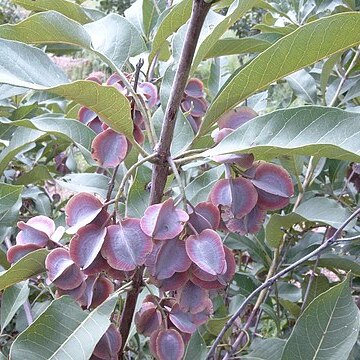A small tree. It grows 8-10 m tall. It loses many leaves during the year. The crown can be rounded or flat. The bark is reddish brown or pale brown. The leaves can be opposite or alternate. The leaf blade is 20 cm long by 8 cm wide. It varies in shape. There are 6-14 pairs of side veins. The flower clusters are 10 cm long and usually in the axils on the current year's growth. The flowers are yellow. The fruit are brown to purple and 3-5 cm long by 3-5 cm wide. They vary in shape. There are several subspecies.
Leaves opposite or alternate or verticillate; lamina up to 19(25) x 8(9) cm., very variable in shape, when dried brown or buff or golden-brown or silvery and usually somewhat “metallic” in appearance, densely tomentose to nearly glabrous (except for scales), conspicuously lepidote except when the scales are hidden by the indumentum; lateral nerves 6–14 pairs; reticulation usually (but not always) fairly prominent beneath; petiole usually up to 3(5) cm. long but very variable.
Fruit brown or greyish-brown or reddish-grey to dark-purple, usually somewhat “metallic” in appearance, 2·5–5·5 x 2–5·5 cm., variable in shape, lepidote with scales often contiguous, glabrous (except for scales) to densely hairy, glossy or dull, wings variable in breadth, stipe up to 2 cm. long.
Lower receptacle 2–4 mm. long, glabrous (except for scales) or hairy, lepidote; upper receptacle 3·5 x 2·5 mm., campanulate at the base and cupuliform at the apex, lepidote, glabrous (except for scales) to tomentose.
Petals 1·5–2·5 x 1–2·5 mm., transversely elliptic to obovate or subcircular, somewhat emarginate, unguiculate with the claw up to 1 mm. long, glabrous (rarely with a few hairs at the apex).
Scales 80–180µ in diam., extensively divided by many radial and tangential walls to give 16–40 marginal cells; scales often contiguous on the lower epidermis of the leaf.
Small semideciduous tree up to c. 17 m. high or shrub; crown rounded to flat; bark reddish-brown to grey or black or pale yellow to creamy-brown.
Inflorescences of axillary spikes or panicles up to 10 cm. long, usually in the axils of bracts or reduced leaves on the current year’s shoots.
Cotyledons 2, arising below soil level on a stalk formed by their connate petioles, free part of petiole 2 mm. long.
Disk 2 mm. in diam. with pilose margin free for c. 1 mm.
Stamen-filaments 4–4·5 mm. long; anthers 0·9 mm. long.
Flowers sessile, white or yellowish-green.
Sepals 0·8 x 1·2 mm., broadly triangular.
Style 4 mm. long, glabrous or pubescent.

